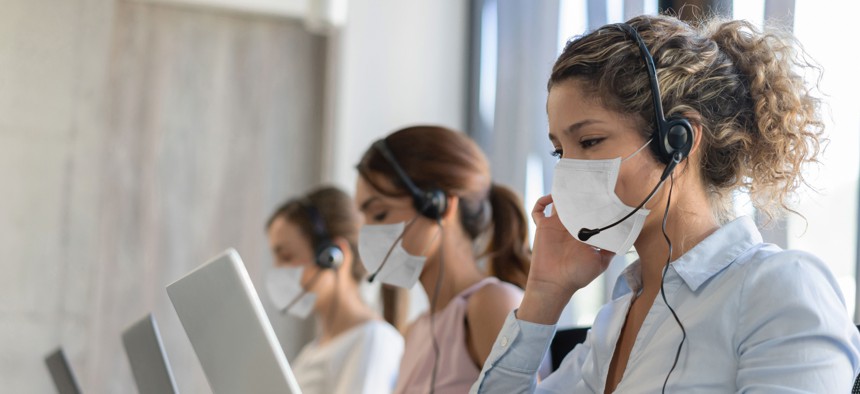The 311 Lifeline: How Governments Enhanced Call Centers During the Pandemic

iStock.com/andresr
State and municipal governments established special hotlines or expanded the type of services residents could access through 311 call centers during the pandemic.
When a streetlight is out or trash pickup missed, residents often turn to their city’s 311 call center to report the problem. But municipal call centers took on elevated importance during the coronavirus pandemic as cities expanded their role, offering new services like Covid-19 vaccine appointment bookings or hotlines to help people understand financial assistance programs.
While some municipal governments struggled with vaccine management software, New Orleans officials opted to integrate appointment bookings into their existing 311 call center platform. The result was a 24-hour hotline residents could call to schedule vaccine appointments, file complaints about businesses flouting coronavirus restrictions, or to connect residents with quarantine resources such as food delivery, said Tyrell Morris, executive director of the Orleans Parish Communication District, which oversees the city’s 311 and 911 call centers.
“I can’t imagine what we would have done if we didn’t have that level of access,” he said.
When the pandemic hit, officials in Buffalo, New York anticipated that residents would need more information from local governments. The city transitioned its 311 call center staff to remote work in under a week so that there would be no interruption of communication services when workers stopped reporting to offices in city hall because of the risk of infection.
New Orleans also experienced an increase in demand for information, and responded by expanding 311 services through an artificial intelligence-powered chatbot that residents could text with service requests and other questions. Call takers expanded their role by proactively checking in on residents who tested positive for Covid-19 to offer additional services or assistance. The city increased the number of full-time call takers from four people to eight to handle increased call volume, Morris said.
Millennials and younger residents were more likely to access city services online or through the chatbot or online, but the call center was a lifeline to older residents and those without internet access, Morris said.
The city hopes to harness the growth in connectivity to offer more holistic assistance to residents through the call center in the future.
“In pre-covid days, if you wanted something done in city government, you had to get up and go to that city agency,” Morris said.
But he envisions a scenario in which residents call the city’s 311 center and call takers can see that resident’s interaction with the city, whether it’s visits to a library or recreation center or prior service request calls.
“When someone calls 311, we should be able to see every time they interacted with city government so we can meet their needs,” Morris said.
City officials did not provide requested information about call center volume or costs by deadline for this article.
Maryland saw a huge demand for information through its health department-run GoVAX call center. The state reported more than 2.2 million inbound calls for coronavirus-related information since it launched in February. Call takers were able to schedule more than 460,000 vaccine appointments, including more than 5,000 vaccine referrals for homebound residents.
“We saw how effective the call center was in the first few days of operation,” said Dennis Schrader, secretary of the Maryland Department of Health, in a statement. “It became clear that we could utilize the call center as a resource for a variety of activities designed to put vaccines in the arms of every Marylander, regardless of their circumstance.”
The call center team also does information outreach, calling or texting residents to deliver Covid-19 test results or let them know when they become eligible for booster shots. The call center employs more than 200 call takers who work remotely, DOH spokesman Andy Owen said. The state allocated $34 million in federal funding to pay for the call center.
"The human connection provided by live staff over the phone, via text, and through the web live chat has made the call center not only an efficient, but also a highly effective, way to reach hesitant and hard-to-reach groups," Owen said.
Other governments have used call centers to inform residents about financial assistance available during the pandemic. California started a rent relief hotline where residents could get information about applying for emergency rental assistance. Detroit opened a call center to help advertise the Federal Communications Commission’s Emergency Broadband Benefit Program to residents. The hotline uses the city’s local 313 area code, and provides residents with information on how to qualify and sign up for the federal program, which provides $50-a-month subsidies for internet service to needy households.
Andrea Noble is a staff correspondent with Route Fifty.
NEXT STORY: Taking Race Out of Criminal Charges





